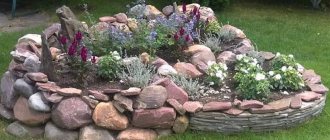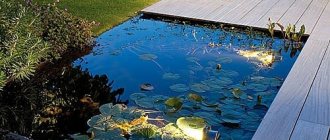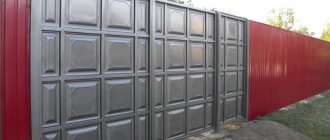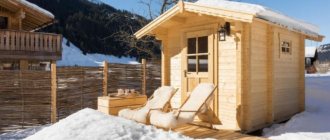Landscape design is a real art that will change the appearance of any plot of land beyond recognition. There are many techniques to create images of different styles. Many people love flower beds, areas with a smooth green lawn, artificial ponds, fountains and waterfalls, and natural alpine slides. Among the diversity was an unusual phenomenon called a dry pond or dry stream.
Option for a dry pond in a summer cottage
Dry Stream Materials
To develop a dry stream or even a dry lake (if the site is of sufficient size), you will need inexpensive materials.
First of all, you should decide on the design of the dry stream. It can be done:
- from flowers;
- from pebbles;
- from crushed stone;
- from gravel;
- from basalt;
- from slate;
- from gneiss.
If you decide to make a dry stream of flowers, you need to choose plants that grow in a mat and bloom with small blue flowers, as shown in the photo, - this will imitate the color of the water.
If a concrete jungle appears in your imagination, then you should buy pebbles, crushed stone or gravel.
- A DIY mailbox is a beautiful decoration and a useful addition to a suburban area
A house for children is a place where a fairy tale becomes reality, we create it ourselves
Bridges for a dacha - a picturesque element of the landscape in a suburban area
If you choose blue pebbles or gravel, your dry pond will closely resemble the real one. Don’t forget also about large stones that you can use to line the shores of a dry reservoir.
Care
Caring for a dry stream is not difficult. It is enough to keep it clean. Weeds will not grow from below, because the top layer of soil has been removed and covering material has been laid. But weeds can sometimes appear on top. As necessary, clear them, as well as any fallen leaves from stones and the surrounding area.
If there are plants along the banks, then they also need to be periodically weeded, watered and fertilized, if necessary for the selected varieties.
With minimal care, your stream will look attractive for many years.
It is also advisable to sometimes lift large stones and check whether ant families have settled under them. They need to be destroyed, without allowing the ants to disturb the created beauty of the landscape design and the dry stream that you so diligently made with your own hands.
Types of dry stream
Before you begin, you should decide on the design of the dry stream. You should not make it straight - this way it will look more like a path rather than a flowing stream.
Designers offer several types to choose from:
- meandering (usually done with different channel widths);
- branched (several streams can converge in one place or, on the contrary, diverge from one point in different directions);
- waterfall (used in an area where there is a hill).
If the area is long and narrow, a dry stream may flow into an equally dry lake. And if it is wide and small, then it is better to use a winding stream - it will visually deepen the space.
Advantages
Let us list the main advantages of the decision to create a dry stream on a summer cottage:
- The preparation and creation process takes a minimum of time.
- There is no significant financial investment required to purchase expensive water pumps.
- Caring for a stream is very simple: just periodically pull out the sprouting weeds.
- On the “shores” you can create a real flower paradise.
- A dry stream, unlike a regular stream, is safe for children.
- It will help solve the problem of flooding at home by diverting water away from it.
- It will hide the shortcomings of the natural landscape of a personal plot - even differences in height can be presented as waterfalls.
- If desired, it will visually divide your site into several separate zones.
- Finally, a dry stream will add beauty and originality to your garden, becoming its real decoration.
Examples of dry streams in a summer cottage (photo gallery)
Dry stream planning
First of all, you need to mark the future structure. The easiest way to do this is to draw the contours of a dry stream with sand. If you don’t like something, you can always correct it by changing the width or bend of the channel.
Please note that in different areas the width of the stream should be different - just like in wildlife. And be sure to avoid sharp corners in the design of a dry stream - it will look unnatural.
Creating banks
Larger stones are placed on the boundaries of the resulting stone flow, forming the banks of the creation, or plants and flowers are planted. Representatives of the flora can also be planted between boulders.
However, it must be remembered that too tall plants can destroy all the beauty of a man-made stream. Most often, small plants are used here: marigolds, saxifrages, hosts, daylilies, and lobelias.
Main stages of work
Having decided on the further form, you can begin to work. First you need to clear the land intended for the pond from turf.
Next, go 15-25 cm deep into the ground. Level the bottom of the stream with a rake. To further protect yourself from the appearance of weeds between the pebbles, you should line the bottom with polymer film, lutrasil, or geotextile.
You can even fill it with concrete. But in this case, if you wish, you will no longer be able to “move” the bed of your dry stream to another place.
When the site is ready, you should begin filling the “pool” with the selected material. You should start with cobblestones, which are placed along the edges of the reservoir.
To these you can add pieces of multi-colored granite, sold in hardware stores. They should be supported naked so as not to sway from the wind.
Next add pebbles. Here you should call on all your imagination to help, because you can use materials of different colors and structures, laying out fancy patterns from them.
And the icing on the cake will be glass balls scattered at random (preferably blue) - they will create the illusion of water droplets.
By the way, stones can be painted with varnish, and then they will appear wet. If you paint the stones with luminescent paint, they will glow in the dark.
You can also create islands “downstream” from a pile of large stones. You can do whatever your imagination suggests.
Pick up the stones
To fill the stream itself, smooth river stones are usually used, but “rougher” rocks look organically in the decor of the banks. Massive, as if cut down, cobblestones can also serve as a landscape dominant.
If you want to achieve the effect of a water surface, then pebbles of one fraction will look most advantageous in this case. However, you can deviate from this rule to experiment with stones of different sizes. However, such “flirting” with forms can turn into a complete fiasco for you. Proceed very carefully if you do not fully understand the end results of your experiment. General rules for using stones of various sizes:
- for the central part of the channel - stones 2.5-7 cm;
- for edges and slopes - cobblestones 10-20 cm;
- for coasts and hills - rocks measuring 30-45 cm;
- Giant stones from 45 cm or more are used to create compositional dominants.
When sorting stones by color, please note that when creating rapids and dry waterfalls, it is better to use materials of lighter shades.
Pond decoration
The job is done, but it seems like something is missing? Of course, plants! Flowers should be planted around a dry stream to make it look as natural as possible.
The choice of plants to decorate the stream is yours. Just don’t take ones that are too tall, as they will block the entire view of the pond.
Blue flowers with long leaves are best associated with water. Just don’t plant them in orderly rows under any circumstances – everything should be random, just like in the wild.
In addition to plants, driftwood, garden sculptures, and even small bridges across the “stream” can be used to decorate a dry stream. Just do not overdo it in this matter, so as not to drown out the effect of the water flow created by a dry stream.
Now that you can unbiasedly evaluate all the advantages of a dry stream over an artificial pond, you can safely begin designing and arranging such decoration for your land.
History of origin
A dry stream for landscape design came to us from Japan, where it became the personification of water, without which not a single Japanese person can imagine life.
For the inhabitants of the Land of the Rising Sun, water is a symbol of continuous movement and the desire to learn something new.
Here such a stream has long become the main element of rocky gardens. After all, he was able to successfully supplement the landscape with imitation water in those places where it is not possible to create a real body of water.
Next steps
We continue to make a dry stream with our own hands in stages, and now we need to lay out stones on the formed surface. Start laying out from the bottom of the riverbed, having first sprinkled it with crushed stone and expanded clay (the height of the layer should be on average about five centimeters). Next, sprinkle the surface with sand.
Since our stream will flow from an imitation rock, use the largest pebbles. Form a mound, install stones, and fill the gaps between them with crushed stone so that the composition looks complete.
DIY dry stream, photo
You can see clearly how to create a dry stream in the landscape design of your garden in this video:
Next, start creating an imitation of the flow of a mountain stream. For these purposes, use flat pebbles. It is better to place voluminous pebbles along the two edges of the stream. Here, form the coastline by laying out large blocks.
Tip: For a realistic effect, make one edge of the stream more rocky. This is where you should ensure that the largest stones accumulate. On the opposite side they will have smaller parameters.
The shallow water area of our homemade stream will be formed using small pebbles or other stones. A rough current can be simulated using flat pebbles laid out on an edge. Decorate the center of the riverbed with a hewn boulder, and around it decorate it with a homemade whirlpool of pebbles.
You can play with the depth of a homemade “water” object. The darker the stones, the deeper the area being designed will appear. Accordingly, we form shallow water zones from light stones, glass or plastic.
If you are concerned about the destruction of the composition during periods of heavy rain, you can strengthen the elements of a dry stream by making a reliable base for them, filled with a solution of sand and cement. The stones are placed in a solution in which they harden. If necessary, cover them with paint of a suitable color.
Dry stream at the dacha, photo
And, of course, don’t forget about additional decorative elements. Form a bridge, taking care to securely fasten it. If desired, decorate the bridge itself with decorative fencing or lamps.
Dry stream with a bridge, photo
The stream should pass through it. Place a small mill or other structures nearby that will look harmonious against the general background. They should also be installed in the ground so that during periods of strong winds these parts do not tilt.
After installing these elements, all that remains is to think about decorating the stream with natural vegetation. If necessary, prepare the soil around the stream or in the areas where you plan to plant. You can create small borders to make the borders look neat. Plant plants taking into account their aggressiveness towards each other.
And don’t forget to promptly care for the green areas of your composition: they will need to be weeded and watered. Annual flowers and plants will have to be removed after the end of the season, so it is better to stick to more unpretentious plants.
DIY dry stream at the dacha, photo
By the way, it is not at all necessary to strictly adhere to our recommendations for arranging such a recreation area. You can safely implement your own ideas. The main thing is that such a stream looks realistic and retains its shape, otherwise you will have to constantly adjust it.
Look at the options for such decor - and you can start drawing up a plan for a dry stream on your site.
Lay out the stones
It’s better to start with the placement of accents, i.e. Boulders are the first to fight for beauty on your site. Go around your stream from all sides again and think about where the largest stones from your “collection” would look best. Since your main goal is to imitate a real stream, place the boulders so that, on the one hand, they create the illusion of randomness, and on the other, they harmoniously complement the landscape.
Then line the banks with cobblestones, and the slopes and riverbed with smaller stones. This ranking of stones by size - the smaller the fraction, the lower the location - imitates the natural arrangement of rocks in the river. There, small stones are constantly washed away by water from the banks and gradually move to the very bottom.
Photo gallery
Look at another small selection of photo ideas of dry streams and options for their use in landscape design of the site:











